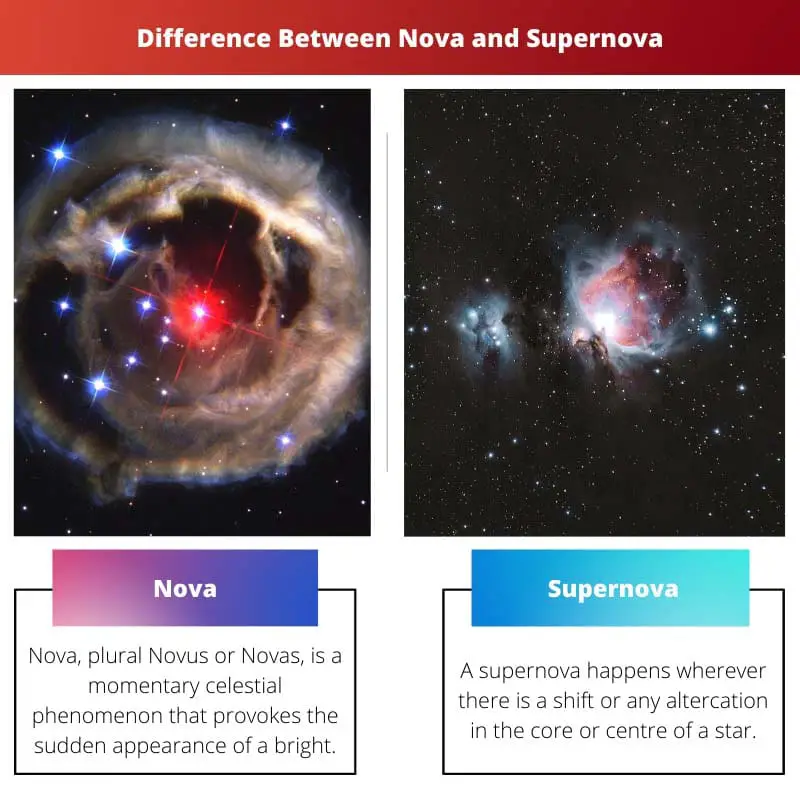Both Nova and Supernovas are two phenomena of the universe. Nova is a star that suddenly becomes very bright and then slowly returns to its original brightness level over a few weeks, which can also be extended over many years.
On the other hand, Supernova is a sporadic celestial feature that involves the explosion of most of the material in a star, resulting in a very bright, short-lived object that releases enormous amounts of energy.
Key Takeaways
- Nova is a sudden increase in the brightness of a star that lasts for a few weeks, whereas a supernova is a much more powerful explosion that can last for months and release enormous amounts of energy.
- Nova occurs when a white dwarf star absorbs matter from a nearby star, while a supernova occurs when a massive star runs out of fuel and collapses under its gravity.
- The brightness of a nova can increase up to 100,000 times its original brightness, whereas a supernova can increase up to billions of times its original brightness.
Nova vs Supernova
Supernova releases much more mass as compared to that Nova. The group which is emitted from Supernova is more than that of the Sun as well. And as the mass excreted from the Supernova is a bit too much, it disrupts the host start. That is why Supernova destroys its host star, but Nova does not.

A nova is a provisional, transient astronomical phenomenon that causes the unexpected or sudden appearance of a bright, supposedly “new” star, which slowly fades over several weeks or months.
Causes of the climactic appearance of a nova differ depending on the circumstances of the two-parent stars. The literal meaning of the word nova was derived from the Latin “Novus,” or “new”.
A supernova is a powerful and luminescent stellar explosion. This temporary astronomical phenomenon happens during the last evolutionary stages of a massive star or when a white dwarf is triggered into runaway nuclear fusion.
Supernovas are challenging to be spotted in our Milky Way Galaxy. This happens because the dust blocker disrupts the view. It is mainly spotted in other universes.
Comparison Table
| Parameters of Comparison | Nova | Supernova |
|---|---|---|
| Mass Discharge | Releases less Mass. | Releases enormous amounts of mass. |
| Energy Discharge | Releases less Energy. | Releases massive amounts of energy. |
| Frequency | It occurs and more frequently. | Does not occur often. |
| Place of Occurrence | It can occur more than once in the same place. | It does not occur in the same place more than once. |
| Behaviour towards the host star | Do not destroy the host star. | Destroys the host star |
What is Nova?
Nova, plural Novus or Novas, is a momentary celestial phenomenon that provokes the sudden appearance of a bright, possibly a “new” star that gently fades over several weeks or months, which can also get extended to a few years.
The most common types of Nova are Classical nova eruptions. They are formulated in a close binary star system, which consists of a white dwarf and either a red giant star or a main sequence or a subgiant.
When the orbital period falls in the span of several days to a single day, the white dwarf is near enough to its mate star to begin drawing accreted matter onto the exterior of the white dwarf, which creates a compact, dense, but shallow atmosphere.
This atmosphere around the nova is mainly composed of hydrogen, is thermally heated by the hot white dwarf star, and ultimately reaches a critical temperature producing ignition of rapid runaway fusion.
Nova creates less mass and also releases less amount of energy. And as it does not emit much energy or group, the occurrence of nova does not lead to the destruction of the host star. Nova can happen more than once in the same position.
The literal meaning of the word nova was derived from the Latin “Novus,” or “new”.

What is Supernova?
A supernova happens wherever there is a shift or altercation in a star’s core or centre. The change can be of two types. The first one can be where there are binary star systems.
And the second type is where either core implosion or chemical imbalance can create a supernova.
When a supernova is created, it destroys the host star. This happens because, during formation, the Supernova emits energy in massive amounts, disrupting the host star’s balance. Moreover, a supernova discharges a tremendous amount of mass.
Supernovae can be classified as Type I and Type II. These types are determined based on the chemical reactions during formation. Supernova does not take place in the same place more than once.
A supernova lasts longer compared to a nova.
Because of the dust blocks, we cannot see many supernovas in our Milky Way galaxy. The last Supernova was observed in the year 1604 by Johannes Kepler.
Scientists can understand and know much about the universe by studying Supernova, even though it burns briefly. Scientists have concluded that supernovas are pivotal in distributing components and particles throughout the universe.

Main Differences Between Nova and Supernova
- A supernova releases much more amount of mass as compared to a nova.
- Nova can occur in the same place, unlike Supernova.
- Supernova emits vast amounts of energy, whereas nova emits less.
- A supernova, after formation, destroys the host star, whereas a nova does not destroy its host star.
- Nova occurs very as compared to that of a supernova.


This article provides an in-depth explanation of the differences between Nova and Supernova, which is much appreciated for those who are interested in celestial phenomena.
The detailed comparison table makes it easy to understand and differentiate between Nova and Supernova effectively.
The scientific value of this explanation is commendable, making it clear that Supernova releases much more mass compared to Nova.